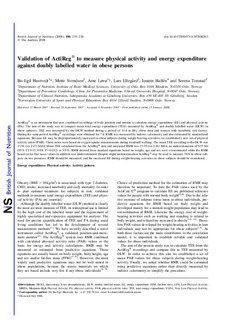Validation of ActiReg (R) to measure physical activity and energy expenditure against doubly labelled water in obese persons
Peer reviewed, Journal article
Permanent lenke
http://hdl.handle.net/11250/170443Utgivelsesdato
2008-01-15Metadata
Vis full innførselSamlinger
- Artikler / Articles [2096]
Originalversjon
British Journal of Nutrition. 2008, 100(1), 219-226Sammendrag
ActiReg® is an instrument that uses combined recordings of body position and motion to calculate energy expenditure (EE) and physical activity (PA). The aim of the study was to compare mean total energy expenditure (TEE) measured by ActiReg® and doubly labelled water (DLW) in obese subjects. TEE was measured by the DLW method during a period of 14 d in fifty obese men and women with metabolic risk factors. During the same period ActiReg® recordings were obtained for 7 d. RMR was measured by indirect calorimetry and also estimated by standardized equations. Because EE may be disproportionately increased in obese subjects during weight-bearing activities, we established a new set of physical activity ratios (PAR). These ratios were based on oxygen uptake measurements during treadmill walking. The mean TEE according to the DLW was 13·94 (sd 2·47) MJ/d. Mean TEE calculated from the ActiReg® data and measured RMR was 13·39 (sd 2·26) MJ/d, an underestimation of 0·55 MJ (95 % CI 0·13, 0·98; P = 0·012) or 3·9 %. RMR derived from standard equations based on weight, age and sex were overestimated while the RMR based on fat-free mass values in addition was underestimated. Despite slight underestimation ActiReg® may be used to measure TEE in obese subjects on two premises: RMR should be measured, and the increased EE during weight-bearing activities in obese subjects should be considered.
Beskrivelse
British Journal of Nutrition (2008), 100:219-226 Cambridge University Press
Copyright © The Authors 2008
doi:10.1017/S0007114507886363. British Journal of Nutrition online: http://journals.cambridge.org/action/displayJournal?jid=BJN
